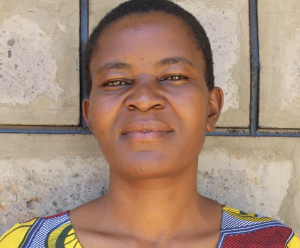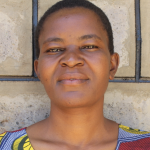June, 2020: COVID-19 Prevention Training Update at Mukhuyu Community, Kwakhalakayi Spring
Our teams are working on the frontlines of the COVID-19 pandemic. Join us in our fight against the virus while maintaining access to clean, reliable water.

Trainer Janet Kayi emphasizes social distancing
We are carrying out awareness and prevention trainings on the virus in every community we serve. Very often, our teams are the first (and only) to bring news and information of the virus to rural communities like Mukhuyu, Kenya.
We trained more than 33 people on the symptoms, transmission routes, and prevention of COVID-19. Due to public gathering concerns, we worked with trusted community leaders to gather a select group of community members who would then relay the information learned to the rest of their family and friends.

Handwashing demonstration
We covered essential hygiene lessons:
- Demonstrations on how to build a simple handwashing station
- Proper handwashing technique
- The importance of using soap and clean water for handwashing
- Cleaning and disinfecting commonly touched surfaces including at the water point.

We covered COVID-19-specific guidance in line with national and international standards:
- Information on the symptoms and transmission routes of COVID-19
- What social distancing is and how to practice it
- How to cough into an elbow
- Alternative ways to greet people without handshakes, fist bumps, etc.
- How to make and properly wear a facemask.

A community member practices the handwashing steps
During training, we installed a new handwashing station with soap near the community’s water point, along with a sign with reminders of what we covered.

Reviewing the prevention reminders chart
Due to the rampant spread of misinformation about COVID-19, we also dedicated time to a question and answer session to help debunk rumors about the disease and provide extra information where needed.

Making a leaky tin
We continue to stay in touch with this community as the pandemic progresses. We want to ensure their water point remains functional and their community stays informed about the virus.

Handwashing demonstration
Water access, sanitation, and hygiene are at the crux of disease prevention. You can directly support our work on the frontlines of COVID-19 prevention in all of the communities we serve while maintaining their access to safe, clean, and reliable water.

June, 2019: Mukhuyu Community, Kwakhalakayi Spring Complete
Mukhuyu Community is celebrating its new protected spring, so celebrate with them! Kwakhalakayi Spring has been transformed into a flowing, safe source of water thanks to your donation. The spring is protected from contamination, five sanitation platforms have been provided for the community, and training has been done on sanitation and hygiene.
Spring Protection
Construction at Kwakhalakayi Spring was successful and water is now flowing from the discharge pipe. The members of this community were so happy with the new project.
"Thank you so much!" said Sarah Machoni.
"Initially, we could waste a lot of time waiting for the sediment in water to settle. Now there is no more wasting time because one just comes and draws water and walks home. There will be no more gossip at the spring because us women will be busy with other duties at home, hence promoting a healthy social life as well as physical life."
Jerida Nangeni said that since she was married into this community, she has never seen trustworthy people like us. She can now fetch water easily despite her old age and will live many more years in this world because she can access clean and safe water.

The Process
The community worked alongside our artisan to make this spring protection successful, gathering supplementary materials like sand and stones and making meals for the work team.

The spring area was excavated with jembes, hoes, and spades to create space for setting the foundation of polyethylene, wire mesh, and concrete. Cement, waterproof coating, ballast, and sand were mixed together to make a very strong foundation.
Brickwork started whereby the artisan took all of the required measurements of the spring structure before proceeding with the work. Construction of the superstructure continued with fixing the discharge pipe in the brick wall. Stairs were built on one side of the spring to allow in and out movement by users.

Stone pitching along the lower part of the spring was done to prevent soil from eroding and blocking the outlet drainage. Finally, the plastering of the walls and the floor was done, and tiles were placed below the discharge pipe to keep the falling water from hitting the cement.
The spring was then left for two days to undergo curing and hardening before being backfilled using stones.

Plastic was stretched across the top and covered with soil to allow clean water to flow from the pipe. Community members promised to dig cut-off drainage at the slope of the spring to divert surface water from entering the area and to also plant grass over the protected area to prevent erosion.
Sanitation Platforms
All five sanitation platforms have been installed and make wonderful, easy to clean latrine floors. These five families are happy about this milestone of having a latrine of their own. We will continue to encourage them to finish building walls and roofs over their new latrine floors as we visit for monitoring and evaluation.

New Knowledge
We visited the site one month before construction work started and during that visit, we were able to request that community members help us mobilize participants to be trained on management and maintenance of the water point. We also made sure to invite all spring users because hygiene and sanitation would be covered in detail.

Participants learned about topics including:
– Leadership and governance for the spring committee
The facilitator asked participants to define the term leader. The following was their response: A person who is given the responsibility to lead a group of people or someone who gives direction to a certain group of people. The facilitator then explained to them that a leader is anyone chosen by a particular group of people to guide, direct, and correct them where they may go wrong.
This topic was special as we looked at the characters of two types of animals, starting with the chameleon. We realized that a chameleon is not a straightforward animal; it keeps on changing its color depending on the situation. It is also very slow and wastes a lot of time. Some members wanted to point fingers at other members in leadership positions, but we put an immediate stop to that. We continued to discuss the qualities of a good leader to encourage those elected to the spring committee.

– Management and maintenance of the spring

We discussed at length what should be done in order for the spring to serve the community members for a long period of time. The spring should be fenced to keep children and animals from interfering with the source, indigenous trees should be planted near the spring, the landowner should avoid farming activities close to the spring, and lastly latrines should not be constructed close to the spring.
Community members wanted to know what would happen if someone is buried close to the spring. According to them, when an unmarried lady dies, she is buried outside the home compound and the best place is at the riverside. The facilitator explained that when the body decays, the particles would find their way into the water. That scared everyone and community members promised never to bury someone by a water source again.

– Family planning
– Personal hygiene, highlighting handwashing and dental hygiene

Following along as the trainer demonstrates the steps of handwashing
There are 10 steps to thorough handwashing, and handwashing should be done with running water and soap.
– Environmental hygiene
– Waterborne and water-related disease, along with water treatment methods
"Thank you so much for serving this community. We have learned a lot through your training we have learned new ideas. This knowledge is going to change this community positively and thus there will be no more bills on medications," said Martin Fundiah.
Community members were very quick to adopt rules for behavior around the spring, and even developed a duty roster for who would cut down brush and routinely pick up litter in the area. We will continue to follow up on the uptake of handwashing and toothbrushing since these were new practices for many of the participants.
Thank You for making all of this possible!


 Protected Spring
Protected Spring
 Rehabilitation Project
Rehabilitation Project









































